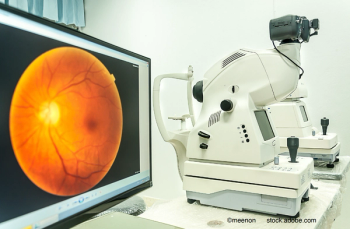
Intravitreal brimonidine holds promise for slowing GA growth
Brimonidine Drug Delivery System (Brimo DDS) in an intravitreally administered, sustained-release implant (Allergan) shows promise as a treatment for geographic atrophy (GA), secondary to age-related macular degeneration in a phase IIa clinical trial.
Reviewed by William R. Freeman, MD
Brimonidine Drug Delivery System (Brimo DDS) in an intravitreally administered, sustained-release implant (Allergan) shows promise as a treatment for geographic atrophy (GA), secondary to age-related macular degeneration in a phase IIa clinical trial.
Based on the encouraging results, a larger phase II study is underway, using an investigational product that will provide more exposure of retinal tissues to the therapeutic agent, said William R. Freeman, MD.
“There is a significant unmet medical need for treatments that can halt or slow the inexorable progression of GA,” said Dr. Freeman, distinguished professor of ophthalmology, and director, Jacobs Retina Center, Shiley Eye Center, University of California San Diego, La Jolla. “Several modalities addressing various pathogenic mechanisms have either failed or have shown minimal efficacy in multiple studies evaluating various mechanisms of action.”
Although this phase IIa study was not powered to show statistically significant differences with regards to efficacy, the analyses showed a statistically significant treatment benefit at month 3 in brimonidine-treated eyes with a trend that is maintained through month 24, 18 months after the last injection.
“I am also happy to report that a second phase II study investigating a second generation Brimo DDS intravitreal implant is completely enrolled and underway,” Dr. Freeman said.
Cyto/neuroprotective agent
Brimonidine is being investigated as a cyto/neuroprotective agent with the goal of reducing the risk of GA progression by making the retinal pigment epithelial (RPE) cells and photoreceptors more resistant to injury.
“It is well known, from results of preclinical studies in tissue cultures of RPE and Müller cells, and in various animal models of retinal disease, that brimonidine has cyto/neuroprotective activity,” said Dr. Freeman.
The completed phase IIa study had a randomized, double-masked, sham-controlled design. It randomized 113 patients into 3 groups (2:2:1) to receive low-dose or high-dose Brimo DDS (brimonidine = 132 mcg and 264 mcg, respectively; formulated as 200 mcg or 400 mcg of brimonidine tartrate, respectively) or sham treatment in the study eye.
The device, built with a biodegradable polymer drug delivery system similar to the dexamethasone implant (Ozurdex, Allergan), was injected into the vitreous with a 22-gauge needle attached to a proprietary applicator system. It is designed to release brimonidine over 6 months, and patients received a second injection at month 6.
Baseline characteristics of the enrolled patients were typical of those expected in a GA population. Mean visual acuity was about 20/80, Dr. Freeman said.
Outcomes
The primary endpoint was the change from baseline in size of GA lesion area at month 12. Compared with the control group, GA progression rate was reduced 18.8% and 27.5% in the low-dose and high-dose Brimo DDS groups, respectively, at month 12.
Although the study was not powered to detect statistically significant differences, analyses of additional time points showed that the rate of GA lesion growth was significantly lowered in both Brimo DDS groups compared with the control arm at month 3.
“A post-hoc sensitivity analysis of the square root of GA lesion area using observed data (i.e., without imputation) was also performed,” reported Dr. Freeman. “This analysis confirmed that mean GA area growth was consistently lower in both Brimo DDS treatment groups throughout the follow-up.”
The difference compared with sham in both Brimo DDS treatment groups increased over time, and approached statistical significance at month 24 for the comparison between the brimonidine high-dose group and sham controls (P<0.059).
The only adverse events reported in the study were events attributed to the intravitreal injection. They included conjunctival hemorrhage, conjunctival redness, and floaters. Intraocular pressure was not changed, which was expected because brimonidine is eliminated through the retina rather than through the front of the eye, Dr. Freeman said.
Next steps
Known as BEACON, the ongoing study of intravitreal brimonidine as a cyto/neuroprotective agent for GA is investigating generation 2 Brimo DDS 400 mcg (formulated as the free base rather than the tartrate form). The biodegradable implant is delivered with a 25-gauge needle and dissolves more quickly, improving retinal exposure to the therapeutic agent. Patients are being treated every 3 months with Brimo DDS 400 mcg or sham, and the primary endpoint is at month 24.
William R. Freeman, MD
This article is based on a presentation given by Dr. Freeman at the Retina Subspecialty Day meeting, held prior to the 2016 American Academy of Ophthalmology meeting. Dr. Freeman is a consultant to Allergan, Genentech, Alcon Laboratories, Spinnaker Biosciences, and Nanovision Group.
Newsletter
Keep your retina practice on the forefront—subscribe for expert analysis and emerging trends in retinal disease management.
















































